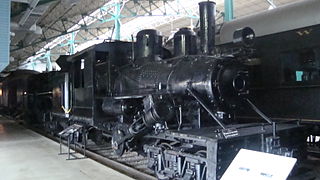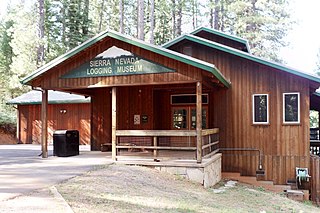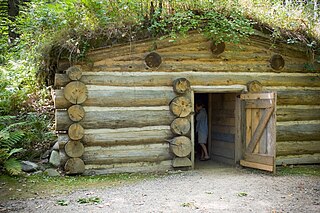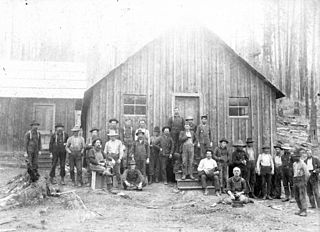
Logging is the process of cutting, processing, and moving trees to a location for transport. It may include skidding, on-site processing, and loading of trees or logs onto trucks or skeleton cars. In forestry, the term logging is sometimes used narrowly to describe the logistics of moving wood from the stump to somewhere outside the forest, usually a sawmill or a lumber yard. In common usage, however, the term may cover a range of forestry or silviculture activities.

Lumberjack is a mostly North American term for workers in the logging industry who perform the initial harvesting and transport of trees. The term usually refers to loggers in the era before 1945 in the United States, when trees were felled using hand tools and dragged by oxen to rivers.

Laona is a town in Forest County, Wisconsin, United States. The population was 1,212 at the 2010 census. The census-designated place of Laona is located in the town. The unincorporated community of Blackwell Junction is also located partially in the town.

Aldo Leopold was an American writer, philosopher, naturalist, scientist, ecologist, forester, conservationist, and environmentalist. He was a professor at the University of Wisconsin and is best known for his book A Sand County Almanac (1949), which has been translated into fourteen languages and has sold more than two million copies.

A Climax locomotive is a type of geared steam locomotive built by the Climax Manufacturing Company, of Corry, Pennsylvania. These had two steam cylinders attached to a transmission located under the center of the boiler, which sent power to driveshafts running to the front and rear trucks. Some 1,000-1,100 were built in three classes between 1888 and 1928.

The Adirondack Park is a park in northeastern New York protecting the Adirondack Mountains. The park was established in 1892 for "the free use of all the people for their health and pleasure", and for watershed protection. At 6.1 million acres, it is the largest park in the contiguous United States.

The World Forestry Center is a nonprofit educational institution in Portland in the U.S. state of Oregon. Located near the Oregon Zoo in Washington Park, the organization was established in 1964 as the Western Forestry Center, with the actual building opening in 1971.

A steam donkey or donkey engine is a steam-powered winch once widely used in logging, mining, maritime, and other industrial applications.

Camp Randall was a United States Army base in Madison, Wisconsin, the largest staging point for Wisconsin troops entering the American Civil War. At this camp fresh volunteers received quick training before heading off to join the Union Army. Also located on the grounds were a hospital and briefly a prisoner-of-war camp for captured Confederate soldiers.

The Sierra Nevada Logging Museum is a museum dedicated to preserving the history of logging in the Sierra Nevada region. The museum is located on California State Route 4 in the Stanislaus National Forest, near Arnold, in Calaveras County, California, United States.

The Laona and Northern Railway is a heritage railroad in Laona, Wisconsin.

Laws is an unincorporated community in Inyo County, California. Laws is located 4 miles (6.4 km) northeast of Bishop on U.S. Route 6, towards the Nevada state line.

The Santanoni Preserve was once a private estate of approximately 13,000 acres (53 km2) in the Adirondack Mountains, and now is the property of the State of New York, at Newcomb, New York.

The Lumberjack Steam Train is a passenger excursion train operated on the Laona and Northern Railway, a heritage railroad located in Laona, Wisconsin and part of the Camp 5 Museum. It is operated by the non-profit Camp 5 Museum Foundation, Inc. The train runs 1.3 miles (2.1 km) from the outskirts of Laona to the museum site.

Laona is an unincorporated census-designated place in the town of Laona in Forest County, Wisconsin, United States. U.S. Route 8 travels east–west through the community and Wisconsin Highway 32 travels south and west of the community. The community park has a sign stating that the community donated the 1979 Christmas tree at the nation's capitol. As of the 2020 census, its population is 519, down from 583 at the 2010 census.

Wabeno is an unincorporated census-designated place located within the town of Wabeno, in Forest County, Wisconsin, United States. It is located on Wisconsin Highway 32 at the eastern terminus of Wisconsin Highway 52 within the Nicolet National Forest. As of the 2020 census, its population was 453, down from 575 at the 2010 census.

The Forest History Center is part of the Minnesota Historical Society's network of historic sites and museums. Located in Grand Rapids, Itasca County, Minnesota, on wooded acreage adjoining the Mississippi River, the Forest History Center provides learning experiences about the forests, logging industry, and forest conservation. The historical and changing relationship between the people and the forest is displayed through exhibits and films, demonstrations, a living history lumber camp, an original 1934 fire tower, and nature trails. The Forest History Center has regular special events, and offers various programs for school field trips.

This is a list of the National Register of Historic Places listings in Forest County, Wisconsin. It is intended to provide a comprehensive listing of entries in the National Register of Historic Places that are located in Forest County, Wisconsin. The locations of National Register properties for which the latitude and longitude coordinates are included below may be seen in a map.

A logging camp is a transitory work site used in the logging industry. Before the second half of the 20th century, these camps were the primary place where lumberjacks would live and work to fell trees in a particular area. Many place names are legacies of old logging camps. Camps were often placed next to river tributaries so that the winter's log harvest could be floated to the lumbermills in the spring.

The Sugar Pine Lumber Company was an early 20th century logging operation and railroad in the Sierra Nevada. Unable to secure water rights to build a log flume, the company operated the “crookedest railroad ever built." They later developed the Minarets-type locomotive, the largest and most powerful saddle tank locomotive ever made. The company was also a pioneer in the electrification of logging where newly plentiful hydroelectric power replaced the widespread use of steam engines.























